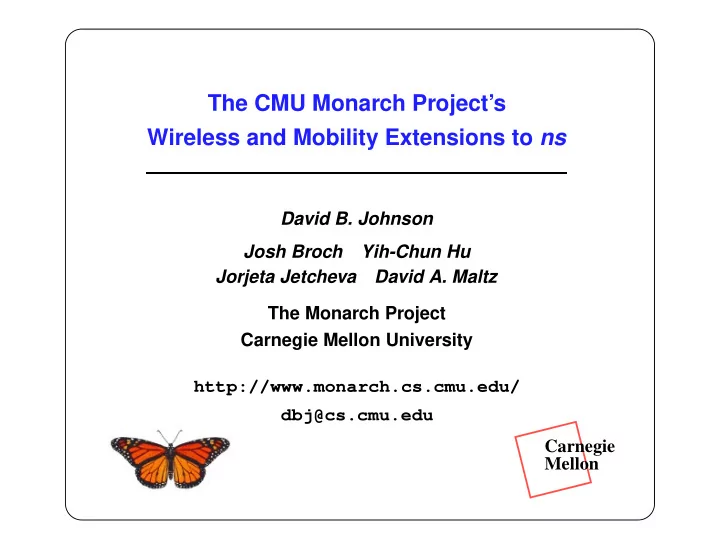

The CMU Monarch Project’s Wireless and Mobility Extensions to ns David B. Johnson Josh Broch Yih-Chun Hu Jorjeta Jetcheva David A. Maltz The Monarch Project Carnegie Mellon University http://www.monarch.cs.cmu.edu/ dbj@cs.cmu.edu Carnegie Mellon
ns (Network Simulator) Advantages of using ns as a basis: � Widely used in other areas of networking research � Provides good support for TCP and other protocols � Freely available in source Problems for wireless and mobile simulation: � Nodes in network have no explicit physical position � Links between nodes are independent: – Behavior/performance not related to node positions – Behavior/performance not affected by physically (electromagnetically) overlapping transmissions on other links
Our Mobility Support Mobility support for each network node: � Each node has location , direction , and speed � Events can be programmed to change direction or speed � Current position of node can always be calculated as function of time Our current movement model ( random waypoint model): � Pick random starting location, then repeat: – Wait for Pause Time seconds – Pick random new destination (uniform distribution) – Pick velocity between 0 and maximum (uniform distribution) – Move steadily to destination � Pause Time controls rate of mobility
Our Physical Link Model Each mobile node may have one or more wireless network interfaces: � Each antenna has a defined offset from node’s location � Each has properties like transmit power, antenna gain, etc. � Interfaces of same type may be attached to a shared channel Mobile Mobile Mobile Node Node Node Channel
Physically Transmitting a Packet To transmit a packet: � Sender calculates propagation delay to all other nodes on channel based on distance and speed of light � Schedules “packet reception” event for each node � Signals arrival of first bit of a new packet Mobile Mobile Mobile Node Node Node Channel
Physically Receiving a Packet When packet reception event occurs: � Receiver calculates received signal strength � Compared to two thresholds: – If below carrier sense threshold , packet is discarded as noise – Else, if below receive threshold , packet is marked as “in error” and passed to MAC level – Else, packet is passed to MAC level
Physically Receiving a Packet (cont’d) � If MAC receiver state not idle, check for capture effect : – If existing receive at least 10 dB > new packet, assume capture, discard new packet, continue existing packet – Else, assume collision, both packets in error � MAC layer schedules “packet reception complete” event for itself based on packet size and channel bit rate � When reception complete event occurs: – Verify packet is not in error, and discard if error – Perform destination MAC address filtering – Pass packet up protocol stack
Radio Propagation Model Combined Friss free-space and two-ray ground reflection model: =r 2 � Up to reference distance , attenuation is 1 =r 4 � Beyond this, attenuation is 1 r is distance between transmitter and receiver antennas � � This is standard approximation used by radio engineers � Assumes specular reflection off a flat ground plane Enhancements in progress: � Blockage, reflection, diffraction off of terrain � Also off of moving obstacles
Additional Support Media Access Control (MAC) protocol � Full implementation of IEEE 802.11 Distributed Coordination Function (DCF) � Similar to MACA and MACAW: – Unicast packets use RTS/CTS/Data/ACK exchange – Uses both physical carrier sense and virtual carrier sense Address Resolution Protocol (ARP): � Based on standard BSD ARP implementation � Buffers one packet while waiting for ARP Reply
Visualization and Scenario Tool Also developed ad-hockey tool: � GUI tool for building movement and communication scenarios of nodes in ad hoc network � Visualizer for output of simulation runs Uses X-Windows, Written in Perl/Tk
Scenario Generation Example
Trace Visualization Example
Status and Availability Standard ns is available from: � http://www-mash.CS.Berkeley.EDU/ns/ Release 1.0.0 Beta of our extensions released August 12 on our web pages at: � http://www.monarch.cs.cmu.edu/ We have used in large simulation of ad hoc routing protocols: � “A Performance Comparison of Multi-Hop Wireless Ad Hoc Network Routing Protocols,” to appear at MobiCom’98 , Oct 25–30, 1998, Dallas, Texas � DSDV, DSR, TORA, and AODV for 50 mobile nodes � Finishing final version of paper right now : : :
Recommend
More recommend